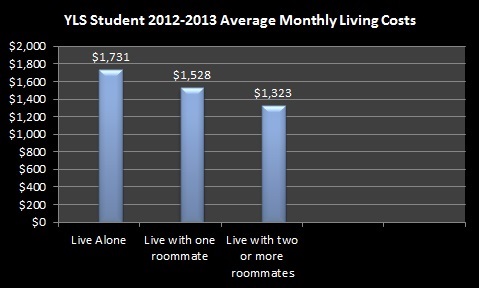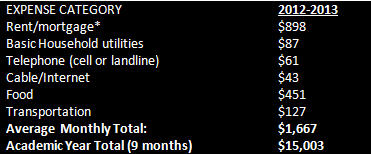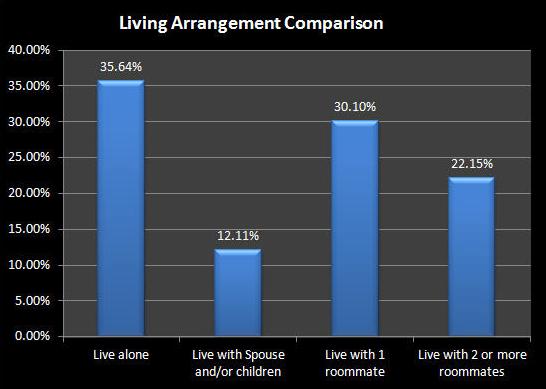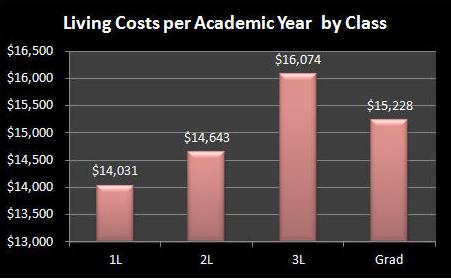Financial Aid Fashion Blogging
So this is my one (and most likely only) chance to join the myriad of “fashion bloggers” out there. Definitely a bucket list item I can now cross off.
So what’s the connection between my real life world of financial aid and the far more interesting world of fashion… budgeting of course (my favorite topic of conversation).
Our 2013-2014 Cost Of Living Survey indicated that on average, YLS students spent $642 on professional clothing last academic year (a significant jump of 18% over what was spent the prior year). That’s a big bite out of the already stretched student budget.
But the reality is that you can indeed “dress for success… for less” as our October 20th Financial Literacy Lunch Workshop proved. Fashion editor Shanelle Rein Olowokere (In Style, Entertainment Weekly, People Style Watch, PEOPLE.com and currently senior fashion editor at Goodhousekeeping.com) brought her fashion sense and sensibility to YLS.
Shanelle recognized that YLS students face two distinct challenges- dressing for the nonprofit/public service work environment and dressing for the far more conservative and formal law firm setting. With clothing generously provided by THE LOFT, Shanelle used real YLS models to demonstrate two looks for both the conservative (think firm or clerkship) to casual (nonprofits or new media) work places. Our special thanks to our two models Chelsea Lane-Miller’ 17 and Irina Anta’ 15 for agreeing to walk our makeshift runway (well, okay just the amphitheater stairs in Room 127) . In the photo on the left, Shanelle (right) highlights some of the features on Irina’s “casual work environment” LOFT look , while Chelsea (middle) waits to show a LOFT suit appropriate for “firm wear”. And Shanelle didn’t forget the men- she included in her presentations visuals for optimum casual and conservative looks for them as well.
So here are some of the key takeaways that Shanelle shared-
1) The absolute need to find the right fit- whether that means ignoring the sizing label, making friends with your local tailor or just knowing your body enough to realize what looks right on you!
2) Have a shopping strategy- know how much you can spend (i.e. the all-important budget), know what you need (make a list!), research on line first (saves lots of time browsing through stores) and shop smart (see something you like… wait for it to go on sale!)
3) Work those accessories- want to express your individual style while wearing a relatively conservative wardrobe? Let your accessories (tie, scarf etc.) do the talking for you. But don’t forget that you want quality in those accessories so that they fit well and will last … whether in good (aka comfortable) shoes or leather handbags .
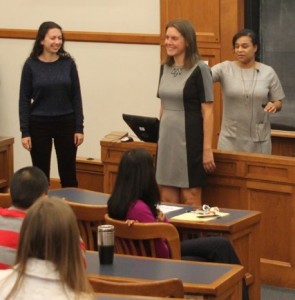 Beyond her basic presentation, Shanelle fielded a lively Q&A session with students that touched on every fashion aspect imaginable from appropriate winter outerwear (answer- classic trench coat and wool coat), whether you can wear black shoes with navy pants (answer- absolutely), if black flat shoes are appropriate (answer- depending on the work environment and if the shoe was constructed well i.e. no ballet shoes), how to work with a tailor (answer- start with alterations to some of your less expensive clothing to see if you like their work before giving them any of your higher quality suits or dresses) to whether you can use a nice leather tote bag in lieu of a purse (answer- yes!) .
Beyond her basic presentation, Shanelle fielded a lively Q&A session with students that touched on every fashion aspect imaginable from appropriate winter outerwear (answer- classic trench coat and wool coat), whether you can wear black shoes with navy pants (answer- absolutely), if black flat shoes are appropriate (answer- depending on the work environment and if the shoe was constructed well i.e. no ballet shoes), how to work with a tailor (answer- start with alterations to some of your less expensive clothing to see if you like their work before giving them any of your higher quality suits or dresses) to whether you can use a nice leather tote bag in lieu of a purse (answer- yes!) .
Above all Shanelle emphasized how important clothes are to not just looking professional but feeling good about yourself in the workplace, which ultimately help your performance. And she gave tips galore on inexpensive brands, sale strategies (shopstyle.com!) and continually proved that you can indeed dress well on a budget (provided you make a budget!).
And so ends this post from the self-proclaimed “Financial Aid Fashionista”!


